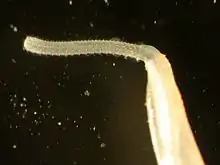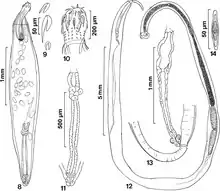Palaeacanthocephala
Palaeacanthocephala ("ancient thornheads") is a class within the phylum Acanthocephala. The adults of these parasitic platyzoans feed mainly on fish, aquatic birds and mammals. This order is characterized by the presence of lateral longitudinal lacunar canals and a double-walled proboscis receptacle.[1] The nuclei of the hypodermis (outer layer of skin) are fragmented and the males have two to seven cement glands, unlike their relatives the Archiacanthocephala which always have eight.
| Palaeacanthocephala | |
|---|---|
 | |
| Proboscis of a Rhadinorhynchus species | |
| Scientific classification | |
| Kingdom: | Animalia |
| Phylum: | Acanthocephala |
| Class: | Palaeacanthocephala Meyer, 1931 |

Two paleoacanthocephalans, Heterosentis mongcai Amin, Heckmann & Ha, 2014 and Filisoma indicum Van Cleave, 1928
There are three orders in the class Palaeacanthocephala:[2]
- Echinorhynchida Southwell and Macfie, 1925
- Heteramorphida Amin and Ha, 2008
- Polymorphida Petrochenko, 1956
References
- Bursey, C. R., Goldberg, S. R., & Kraus, F. (2007). New family, new genus, new species of Acanthocephala (Echinorhynchida) from the lizard, Sphenomorphus granulatus (Sauria: Scincidae), from Papua New Guinea. Open Parasitology Journal, 1, 41-44. Found at: https://benthamopen.com/contents/pdf/TOPARAJ/TOPARAJ-1-7.pdf
- https://www.itis.gov/servlet/SingleRpt/SingleRpt?search_topic=TSN&search_value=196823#null
| Wikispecies has information related to Palaeacanthocephala. |
This article is issued from Wikipedia. The text is licensed under Creative Commons - Attribution - Sharealike. Additional terms may apply for the media files.